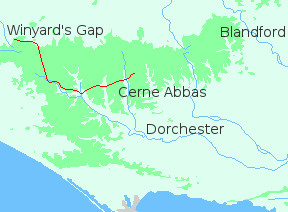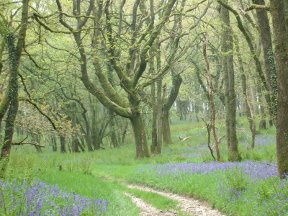
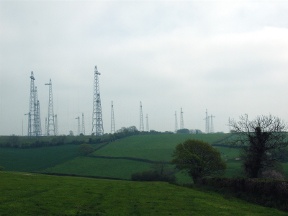
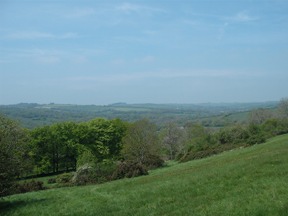
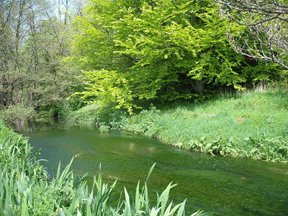
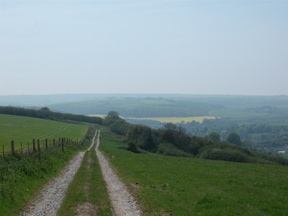
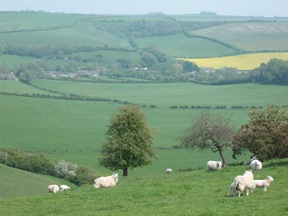
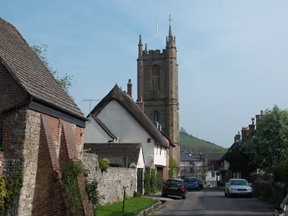
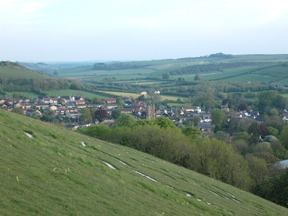
The Winyards Gap Inn is perched on the westernmost spur of the chalk. It had taken me two years to get there, along the great upland way from Kent to Dorset. At Winyards Gap the downs come to an end; there I turned east.
It was a cool, grey morning when I left the Inn, though with the promise of fine weather to come. For a mile the track followed the northern face of the chalk, before tuning away through wet fields flecked with bog cotton. Soon it came to the village of Corscombe: an attractive place, with a long and winding street leading to a little church. Beyond the church a stony path descended cautiously to a small stream. Then it climbed, with more purpose now, out onto the wide, sheep-run pastures of Toller Down.
I crossed the ridge at Toller Down Gate ('Gate' presumably refers to a turnpike once situated here). On the southern side lies Westcombe Coppice, which was perhaps the wood Thomas Hardy had in mind when he wrote in 'Far From The Madding Crowd' of the meeting of Gabriel Oak and Bathsheba Everdene. From wide fields where the cold wind blew a track led down through bluebell-scented darkness to the bright fields of the Toller valley. Here the mist had burnt off and the sun shone.
Near Hooke I joined the Wessex Ridgeway. It avoids the village, sloping up to Rampisham. The masts of the former BBC broadcasting station can be seen from much of Dorset, but it is only when you are close to them that you realize how big they are. The track follows the fence, in the shadow of the great metal giants, then sinks once more to the valley floor, through quiet fields where the breeze ruffles the grass and the only sound is the song of skylarks.
At Lower Kingcombe the Way leaves the Toller valley for good. As you climb to the crest of the ridge there are views of Eggardon Hill far away to the right. Soon the path becomes a lane, leading down to Maiden Newton.
It was here, many years before, that I was offered a lift by an old man driving a tractor. As we travelled he spoke of the war, and planes droning above the quiet countryside, and bombs falling on Rampisham. We spoke, too, of the novels of Hardy, which he knew and loved. He told me that he had lived all his life in the Toller valley: perhaps he lies there now.
Eastward are downs higher and more forbidding than any yet encountered. Great ribs of chalk run south from the heights above the Blackmore Vale, cutting across the Ridgeway. But these obstacles are yet to come: the last miles into Maiden Newton are through fields and along the shaded banks of the Frome. After the hot, dusty uplands the cool clear waters are very welcome. If you require other refreshment, try the café in the back room of the shop. There's a little courtyard where you can relax in the sunshine, and they do an excellent coffee and bacon-and-egg roll!
From Maiden Newton there is a relentless climb to the Dorchester - Yeovil road. Not for nothing is it known as Breakheart Hill. It's a long slog on a hot afternoon, but the views are magnificent. From the main road the track drops down to Sydling St. Nicholas, emerging near the old cross.
There's a pub in Sydling, and a couple of B and Bs, so it would be possible to break one's journey here. The alternative is to push on to Cerne Abbas, which lies beyond the next ridge. Yet another relentless climb, but once you reach the top it's downhill all the way.
I followed the road into Cerne Abbas, which was a mistake. For a small country lane it's surprisingly busy. In spite of the traffic, though, I made it in one piece, at that time in the afternoon when English villages slumber in the sunshine and the pubs are still shut.
Cerne Abbas, as the name suggests, was once a monastic centre. A side road leads out of the main street, past a row of medieval alms houses, to what's left of the abbey. The gatehouse is now a private dwelling, but the rest can be visited. There's not much to see, though the grounds are pleasant and the little exhibition describing the history of the foundation is worth a look. Just outside the entrance is the graveyard containing the famous St. Augustine's Well.
The day I turned up in Cerne Abbas was the one day in the week when the Giant Inn did NOT do food. Typical! However the Royal Oak across the road duly obliged. I left the village at dusk, climbing the near-vertical slope past the huge chalk figure. Then out along the ridge, until it was too dark to go further, and I lay down as the last of the day faded from the sky.

